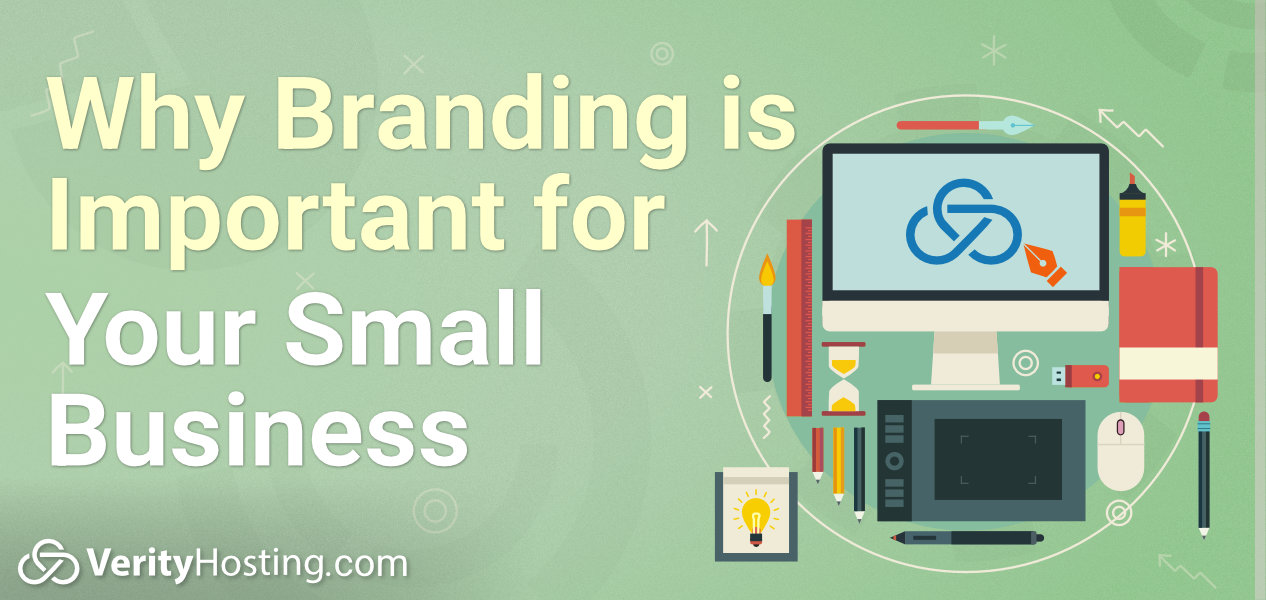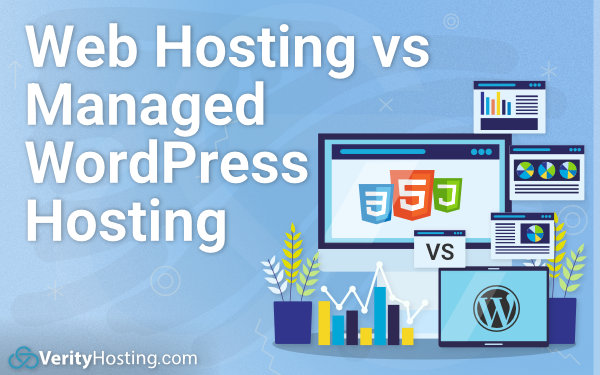
What is Shared Web Hosting?
Learn why shared web hosting may be one of the best hosting solutions for your small business.
Posted on January 19, 2023 | By Verity Hosting Business Post

Need help managing your small business website? click here
Branding makes your company and products more recognizable to everyone. Branding is important for any business, but especially for small business. As a strong brand will help a business stand out in an already crowded marketplace.
It helps a small business build trust with their customers and ultimately helps to drive more sales through a loyal customer base.
Think of a brand as the personality of a business. It sets them apart from their competitors, and it communicates what their business is really all about.
In this article, we show how to boost your small business brand, gain new clients, increase customer loyalty, and build your customer base around it.
Let's get started.
Branding is creating and maintaining a unique, memorable identity for your business, product, or service.
It includes elements such as a name, logo, tagline, colors, and overall aesthetic, as well as the way a business presents itself and interacts with its audience.
Branding is a consistent message and image across all touchpoints of the company, including the website, social media, product packaging, advertising, and customer interactions.
This consistency helps to build trust and recognition with the target audience, and it helps to establish the company as a reputable and credible business.
So contrary to what many people believe, branding is much more than just creating an eye-catching logo. Your brand should provide customers with a look into your business and what it is all about without asking questions.
Branding goes beyond just visual elements and encompasses a business's values, mission, and personality. It helps to create a perception of the company in the minds of customers and potential customers, and it helps to make it unique which separates the company from its competitors.
It can also guide all aspects of a business, from product development to customer service. A well-defined brand can help businesses attract and retain customers, increase visibility, and drive more sales.
Even for small businesses, having a strong brand can not be overstated. Your brand plays a huge part in how customers see your business and the products you offer.
Good branding helps to build reputation, recognition, loyalty, and trust. Studies have shown that a lot of customers make purchase decisions based on the brand's culture and transparency.
Your brand has a lot to say about your company's values, products, customer and employee relations, as well as your societal goals.
The short answer? No
A website is one of the first things business owners think of when they hear about branding. The main issue is that many businesses limit their branding to just their websites, and some even think that websites and branding are the same.
A website is simply an extension and expression of your company's brand. So, although they are related, your website and brand are not the same things, and you should not limit branding to just your website.
Branding is more than just creating a logo or a great website; it is about providing an identity with which your customers will perceive you.
Branding pushes past websites and extends into many different parts, like customer service, product packaging, marketing strategies, etc. Your brand is your personality, and you can exhibit this to your customers in other ways besides your website.
Branding should continue well beyond just your website. Your website is an essential brand touchpoint and should be consistent with your overall branding strategy. However, it's crucial to have consistent branding across all touchpoints of your business.
This includes all your marketing and communication efforts. That means your branding should be consistent across all your offline and online marketing materials, such as business cards, brochures, flyers, email campaigns, social media, packaging, and other marketing materials.
Consistency in branding helps to build trust and recognition with customers, and it will help to establish your small business as a reputable and credible business.
In summary, consistent branding across all touchpoints is essential for small businesses to establish a strong and recognizable image and to create a positive perception of the brand in the minds of your customers.
There are several significant advantages that you stand to gain from having a strong brand. It helps establish good relationships with your clients and your employees. It helps make your business more recognizable. Let us review some of these advantages.
Gaining the trust of your target audience is one of the most essential parts of running a successful business. However, it is not always easy to get.
Quick Note: Getting people to trust you without having a reputable brand can be a near-impossible task.
One of the core reasons branding is so important is that it helps make your business easily recognized by potential customers.
If your business has strong branding, you will captivate more people's attention than a business without branding.
Attractive elements like a unique logo, eye-catching colors, and other tools could keep your business in the minds of potential customers for a long time.
Beyond attracting customers to your business, strong branding also greatly impacts your employees. You should want employees who love working for your company and feel like they are part of a team.
Good branding will make it much easier for employees to see your business as more than just a job.
Because branding changes things like the aesthetics of your office space, business merchandise, and more, it helps in keeping members of the team thoroughly motivated.
In short, branding is essential for small businesses to establish a unique identity, stand out from the competition, build trust and credibility, increase visibility and ultimately drive more sales. A strong brand will give your business a competitive advantage in the marketplace and help it grow and thrive. It is a crucial investment for any business.
The impact that branding has on the success of a small business is often overlooked. And branding your business the right way can be an even more significant challenge.
Since "doing business" became a thing, having a brand that stood out has been vital. Still, it might be even more critical than ever. With the aid of social media, branding can become a potent tool when utilized correctly.
Quick Note: Some key things you will need to know
Creating a strong and reputable brand is essential for the success of your business, as highlighted above. Building a brand is a continuous process and can take time, along with a lot of effort and patience. It's also essential to understand the market and your target audience well. Incorporating a brand into a business involves several steps lets review.
This includes creating a mission statement, identifying core values, and defining the target audience.
You need to take specific steps to ensure your brand is developed in the right way and to a level where it provides all the benefits you expect. Here is an outline of the steps involved in the development process:
Please take some time to consider the aim of your brand. It would help if you thought about the problems your product solves, what makes your business stand out, and how your mission statement is reflected in this goal.
You can then delve deeper into this objective. It should provide great insight into how you can effectively connect with your customers. Outlining your brand's goals from the beginning will make the brand development process more manageable.
It would help if you spent time researching competitor brands. See what your competitors are doing and follow what is working for them. This will help you get some insight into your target audience and how your customers respond to the different brands of your competitors.
By thoroughly researching your competitors, you will gain a level of understanding about your customers and what they like or dislike. This will also have a significant impact on how you develop your strategies.
It is much easier to create a strong brand when you direct it toward a specific group of people.
Refrain from branding with the mindset that a greater target audience is better. In fact, the more you narrow down your target audience, the more efficient your branding will be.
You can find your ideal target niche using market and sales statistics, demographic factors, surveys, and polls, as well as by researching the target audience of competing brands.
Narrowing down on a specific target audience allows you to focus on that group, creating a compelling brand identity that would speak directly to them and their interests.
Some brands are playful, some choose always to be serious, and some even come off as just weird.
Your brand should have a clear personality, which will impact your branding strategies.
A well-defined brand personality will ensure that you maintain an authentic and consistent message across the entire breadth of your business.
The first part of the business that most customers will come in contact with is the visual identity, which tends to be the most familiar and memorable part. The proper visual identity should reflect the purpose and personality of your brand. This visual identity will be used in logos, websites, business cards, and other visual elements across all brand touchpoints.
It is important that this step comes toward the end of the brand development process. Hence, you should already have a clearly-defined personality and purpose before considering the brand identity.
Without passing through all those previous steps, it would be difficult to know those intangibles and how they could affect the outlook of your brand.
Employing a professional to help in this aspect of branding is also a good idea, as they will help you portray your brand's personality using visual elements that will be eye-catching to your customers.
A professional can also help coordinate the color palette that will work best for your brand and a style guide to ensure that you remain consistent across all communication and marketing channels.
Incorporate the brand into all aspects of the business. This includes updating all marketing materials, such as the website, business cards, brochures, and social media accounts, to align with the brand's visual identity. It also includes creating a consistent message and tone across all customer interactions, such as email, phone, and in-person.
Incorporating your brand into your business might be the most important step of the whole process. All the work done in the previous steps will be defeated if you do not successfully integrate your brand into your business.
This incorporation process results in your customers trusting your business more, which is one of the most important factors customers have in mind when making purchase decisions.
Integrating your brand into your business implies that every part of your business is well represented in your brand, including physical stores, online presence, customer relations, and even email communications.
Your staff also have a vital part to play in marketing your brand, so you should provide them with training to ensure they understand your brand and its importance. These steps will set your business on the right path to success.
Brand guidelines include creating rules for how the brand should be presented, including messaging, tone, and visual identity. Employee behavior should be an important part of your guidelines.
It's essential to train employees on the brand's mission, values, and guidelines so that they can represent the brand consistently and authentically. Employee training plays a vital part in your branding. Make sure to pay special attention and ensure all employees understand your branding guidelines.
Continuously monitor your brand to ensure consistency, adapt to changes in the market, and make necessary changes to the branding strategy.
Incorporating a brand into a business is a continuous process that requires commitment and consistency. By following these steps, a business can create a strong and recognizable brand that resonates with its target audience and helps seperate itself from it's competitors.
The foundation of a brand is built on several key components. All of these components work together to create a strong foundation for your brand, which helps to separate it from competitors and build a loyal customer base.
A clear and compelling mission and set of values establish the purpose and personality of a brand. It helps define what the brand stands for and guides all decision-making and actions within the company.
This dictates the primary aim towards which the brand's main efforts are directed. It also impacts how the business acts in specific situations.
Understanding the target audience is crucial for developing a brand that resonates with your customers. By understanding their needs, wants, and pain points, a brand can create messaging and content that speaks directly to them.
A unique value proposition (UVP) is a statement that clearly defines what sets a brand apart from its competitors. A UVP helps to establish a brand's positioning and helps to seperate it from other brands in the market.
The visual elements of a brand, such as the logo, color scheme, and typography, help create a distinct and recognizable image. These elements should be consistent and used across all touchpoints of the brand.
Consistency in messaging, visual identity and customer experience is crucial for building trust and recognition with the target audience. All elements of the brand should be in alignment and consistent across all touchpoints.
Being true to the brand's mission and values and being transparent in communication with customers and stakeholders is essential for building trust and loyalty.
A brand can actually take on natural human personality traits, coming off to customers as humorous, warm, or even serious. This personality should be conveyed in every area of the business, including employee interactions, as well as in advertising and customer service.
These are the values that your brand lives by, and your business' performance and behaviors are usually judged using this list of core values.
These elements form the foundation of a brand and provide the foundation for creating a consistent and compelling message and image that resonates with the target audience and separates the brand from its competitors.
This segment contains all the parts of the brand that appeal to the visual sense of the customers. Defining your brand's visual identity is essential in building a solid and recognizable brand.
A brand's visual identity refers to the visual elements that make up the brand's image and help create a distinct and recognizable look. These elements can include the brand's logo, color scheme, typography, imagery, and overall aesthetic.
This consistency helps to build trust and recognition with the target audience and establishes the brand as a reputable and credible business.
The visual elements of a brand's identity should also align with the brand's mission, values, and target audience. For example, a brand targeting young adults may opt for a more modern and edgy visual identity. In contrast, a brand targeting older adults may opt for a more classic and sophisticated visual identity.
A well-designed visual identity can also create an emotional connection with the target audience and inspire loyalty. It can also serve as a visual shorthand for the brand, making it easy for customers to recognize and remember.
Overall, a brand's visual identity is a vital element of the overall brand. It should be carefully crafted and consistently applied across all touchpoints to create a strong and recognizable image.
As much as it is vital to maintain a great visual identity, it is also essential that you have strong and steady brand communication. This is all about knowing your target audience and maintaining a regular channel to communicate with them.
You must keep in mind the kind of impression you want to make with your customer, as this will greatly impact how you communicate.
Brand communication refers to the various ways in which a brand communicates with its target audience, including advertising, public relations, promotions, events, and customer service.
Advertising is a paid form of communication that uses various media such as online advertising, print, radio, billboards, and television to reach a wide audience. Advertising will help to build brand awareness, generate leads, and increase sales.
Public relations (PR) is the practice of managing the spread of information between an organization and the public. PR can include media relations, crisis communication, and community engagement. It helps to shape and maintain the reputation of a brand.
Promotions are short-term marketing efforts that aim to increase sales, generate leads, or build brand awareness. Promotions can include discounts, contests, and giveaways.
Events such as product launches, trade shows, and sponsorships can help to create a personal connection with customers and generate buzz around a brand.
The way a brand interacts with its customers can have a significant impact on the brand's reputation. Providing excellent customer service will help build trust and loyalty with customers.
All of these forms of communication should align with the brand's mission, values, and target audience. They should also be consistent in messaging, tone, and visual identity.
By communicating effectively, a brand can create a positive image, build trust and loyalty with customers, and ultimately drive more sales.
If you think that branding only works for large corporations, then think again.
Having a clear and consistent brand message will help your small business attract the right customers and keep them coming back. It also makes it easier for your business to separate itself from your competitors, which is especially important for small businesses facing competition from larger and well-established companies.
A strong brand will influence a small business customer's purchase decision. In contrast, a nonexistent or poor brand will be a powerful red flag to your customers.
A good brand identity will significantly boost the company's value, attract more customers with greater ease, and provide employees with the right direction and motivation.
Investing in branding builds trust with your customers. A professional, polished brand will make customers feel more confident in your business and its products or services.
In short, branding is essential for small businesses to establish a unique identity, stand out from the competition, and build trust in their companies. Branding, if done correctly, will create a strong foundation for your business and set you up for long-term success.
All photos used have been curated by Verity staff

Verity Editorial Staff
The editorial staff at VerityHosting is a team of hosting experts with over 25 years of experience managing, monitoring, and maintaining hosting services for small businesses.
Get helpful small business tips from VerityHosting.com

Learn why shared web hosting may be one of the best hosting solutions for your small business.

Learn what web hosting is and how to choose the best hosting provider for your next project.

Here are some great reasons why your small business needs a website. See why it is one of the best things you can do for your small business.
Verity Hosting - Providing professional managed hosting services while being focused on helping our clients to build a successful business on the web and on mobile.